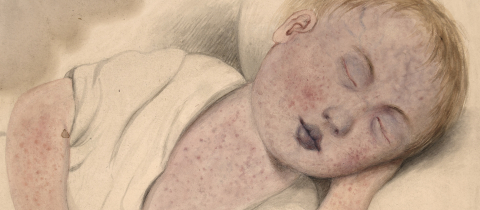It may seem as if flu viruses get chosen based on a sluggish and never-ending game of bingo.
H1N1? … Does anyone have H1N1?
The next number is… H7N9. Please check your cards, the number is H7N9….
H5N1… do we have a bingo? Please bring your card in to be validated. The prizes tonight include congestion, fever, and sore throat.
The majority of flu cases this season are said to be “A(H3N2)”. Who comes up with these designations and what do they mean? As is often (but not always) the case in science, there is a method to this apparent madness.
The illness we commonly refer to as “the flu” is caused by a series of viruses called influenza viruses.
Let’s stop here. What is a virus? Beyond this hazy picture of an invisible microbe that causes ill health, a virus must fulfill the following conditions:
1. It is a parasite that infects a host and makes more of itself inside the cells of said host;
2. Its genetic blueprint is made up of either DNA or RNA;
3. Virus particles assembled inside the host cells break free and go on to infect other cells.
A virus is different from a bacterium, as bacteria are typically much bigger and can make more of themselves without taking over the host’s cellular machinery. Viruses are lean, mean, primitive infectious machines: there is on-going debate about whether or not they are even alive.
Now that we’ve established the differences between bacteria and viruses, it is important to distinguish between the flu and a common cold. While viruses are the causative agents in both cases, these viruses are quite different. Over a hundred different viruses can cause the common cold whereas only influenza leads to the flu.
There are four species of influenza: A, B, C, and D. Within the influenza virus A species exist multiple subtypes: H1N1, H3N2, H9N2, etc. To understand how these subtypes come about, we need to look at the molecules that make up the influenza virus and the way in which the virus replicates.
If you look at viral infection from an engineering perspective, the virus must make contact with a human cell, stick to it, be engulfed by it, take over the replication machinery of the cell to make more copies of the virus and, then, crucially, exit the cell to continue this cycle of infection. The virus must thus possess the necessary tools for each job. The tool required to stick to a cell is hemagglutinin, commonly abbreviated as HA, a protein present on the surface of the virus. This HA protein acts like a highly specific Velcro: if it comes into contact with a molecule called sialic acid, it will bind to it. Luckily for influenza, cells inside the nose and throat express sialic acid at their surface. The influenza virus can thus stick to them.
Once the virus has stuck to the surface of a human cell, it is engulfed by it and enters its interior. It is, however, contained within a membrane: one can imagine the virus being trapped inside a garbage bag inside the cell. The cell acidifies the pH inside this bag in order to get rid of it. The virus, however, has evolved to be quite clever. As the pH of its immediate environment decreases, the virus’ HA protein changes its shape into that of a grappling hook. The viral particle fires up this hook into the wall of the bag and pulls itself right next to its membrane. The virus’ own membrane then fuses with the skin of its cage, allowing the virus to release its deadly poison: its genetic blueprint.
This small genome makes its way to the human cellular machinery which treats it as one of its own: from it, it builds and assembles the blocks that will make little baby viruses. Once these viruses are made, however, they are still trapped within their host cell. Now’s the time to leave the womb.
A second viral protein enters stage left. Its name is neuraminidase or NA for short. Neuraminidase is the virus’ answer to its own Achilles’ heel. You see, all of these viral “pups” ready to burst out of the cell in which they were born are covered in hemagglutinin. As soon as they touch the outside of this cell, they will stick to it. A mighty viral invasion would thus be quickly curtailed by the very mechanism that facilitates influenza’s entry into the immortality machine.
Neuraminidase is a highly specific sickle that cuts sialic acid molecules from the surface of the human cell. As the viral “pups” make their way out, NA essentially removes the Velcro from the surrounding area, ensuring the new-fangled viruses disperse upon emerging from their womb.
The reason NA does not interfere with sialic acid upon entry of the virus into a cell seems to do with speed. As the virus is quickly taken in by the cell, NA lacks the time to cleave the molecule from the cell surface.
So what of H3N2, then? The letter “H” represents hemagglutinin; the letter “N”, neuraminidase. Thus, each subtype is classified according to the molecular composition of their HA and NA proteins, which change quite a bit. The genome of the virus mutates randomly (as does ours, by the way): if the letters A, C, G, and T/U change, then the protein they code for will change as well, as one code informs the other. H3N1 and H3N2 thus have similar hemagglutinin proteins, but distinct neuraminidases.
And it is one of these random mutations that is responsible for the decreased efficacy of this year’s flu vaccine. You see, when the vaccine was grown in chicken eggs, the HA gene mutated. This means the HA from the vaccine is slightly different from the HA in the flu virus that is circulating and making people sick. Our bodies developed antibodies against an HA protein we won’t be exposed to.
Even with our current technology, simple mutations continue to help the influenza virus survive in the wild and dodge our efforts to fully protect ourselves against it.
Want to engage with this content? Comment on this article on our Facebook Page!







